You’ll find the right VR training by first identifying your industry’s specific learning objectives and skill gaps. Research platforms offering extensive content libraries tailored to your sector, then evaluate customization capabilities for adapting scenarios to your workplace challenges. Assess integration compatibility with existing training systems and review performance tracking tools for measuring effectiveness. Analyze your technical infrastructure requirements and equipment needs carefully. Partner with experienced VR providers who understand your industry’s unique demands and can guide seamless implementation for ideal results.
Identify Your Industry’s Specific Training Requirements and Learning Objectives
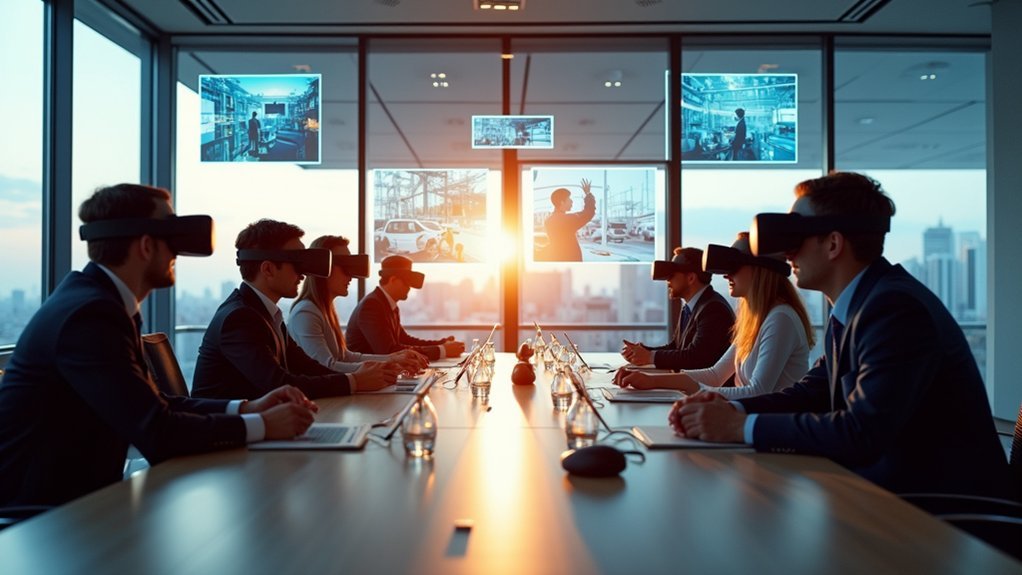
Before you can select an effective VR training solution, you must first pinpoint the exact skills and scenarios that define success in your industry.
Start by analyzing your current training requirements and identifying gaps where traditional methods fall short. Define clear training objectives that align with your professional needs – whether you’re seeking healthcare training for surgical procedures or manufacturing training for complex assembly processes.
Identify training gaps where traditional methods fail and establish clear objectives that match your industry’s specific professional requirements.
Consider what specialized training modules would benefit your workforce most. For instance, healthcare professionals need immersive scenarios that replicate patient interactions, while manufacturing teams require hands-on mechanical simulations.
Research industry-specific VR training options through online resources and professional networks. This experiential learning approach guarantees you’ll invest in solutions that deliver measurable results for your specific sector’s challenges.
Research VR Training Platforms With Comprehensive Industry-Focused Content Libraries
When you’re evaluating VR training platforms, you’ll want to examine the depth and breadth of industry-specific content each provider offers.
Start by determining whether the platform’s library includes specialized scenarios, simulations, and modules that directly address your sector’s unique challenges and skill requirements.
You’ll also need to verify that the platform integrates seamlessly with your existing technology infrastructure and learning management systems to guarantee smooth implementation.
Industry-Specific Content Depth
The backbone of effective VR training lies in platforms that offer extensive, industry-focused content libraries designed to meet specific professional demands.
You’ll want to evaluate how deeply these thorough content libraries explore your sector’s nuances. Look for VR training programs that don’t just scratch the surface but provide detailed, realistic immersive training scenarios that mirror actual workplace challenges.
Industry-specific content should demonstrate authentic workflows, safety protocols, and decision-making processes relevant to your field. The best platforms guarantee practical skill acquisition through scenarios that replicate real-world complexity.
Prioritize systems offering customization of training content to match your organization’s unique requirements. Additionally, seek providers committed to ongoing updates, guaranteeing your relevant training material evolves with industry standards while consistently meeting professional needs for effective training outcomes.
Platform Compatibility Assessment
Since extensive content libraries form just one piece of the puzzle, you’ll need to conduct thorough compatibility assessments to confirm your chosen VR training platform integrates seamlessly with your existing technological infrastructure.
Evaluate how well the platform connects with your current Learning Management System (LMS) to streamline training metrics tracking and content management.
Examine the platform’s customizable content capabilities to verify industry-focused scenarios align with your organization’s specific skill development requirements.
Don’t overlook investigating user testimonials and case studies from companies in your sector, as these provide valuable insights into real-world performance outcomes.
This detailed evaluation approach confirms your VR training investment delivers measurable results while maintaining operational efficiency within your established systems.
Evaluate Customization Capabilities and Scenario Adaptation Features
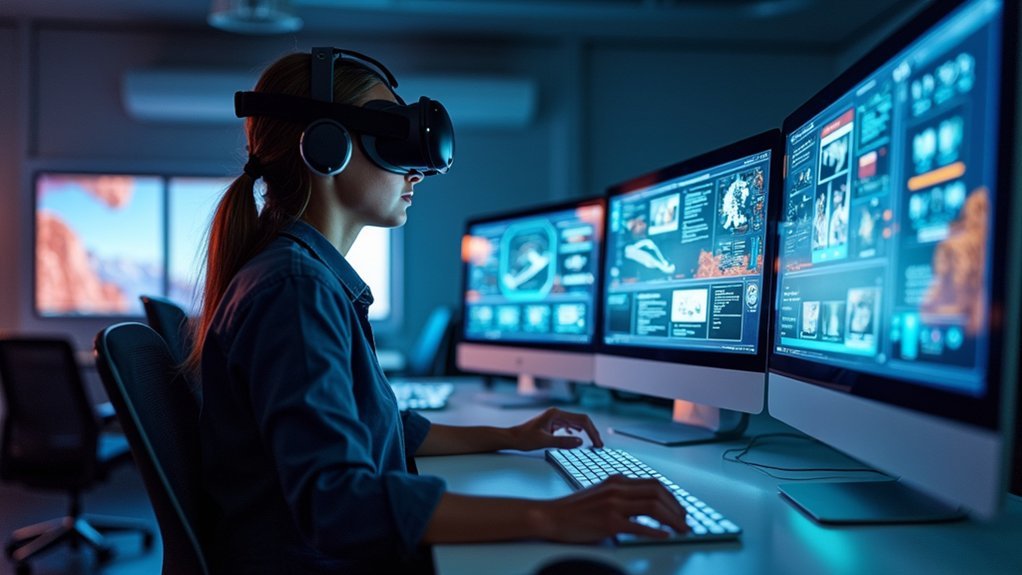
You’ll need to examine each platform’s scenario customization options to determine how extensively you can modify training environments for your specific industry requirements.
Look for industry-specific content adaptation capabilities that allow you to incorporate your company’s protocols, equipment, and workplace challenges into the VR scenarios.
Additionally, assess the availability of real-time modification tools that enable you to adjust training parameters on the fly based on learner performance and evolving business needs.
Scenario Customization Options
How extensively can VR training platforms adapt to your industry’s unique requirements? Scenario customization options determine whether VR training programs truly serve your specific needs.
You’ll want platforms that enable deep modification of environments, challenges, and objectives to create industry-specific scenarios that mirror your workplace realities. This customization directly impacts learner engagement and skill acquisition effectiveness.
Look for systems offering granular control over training content elements—from safety protocols in manufacturing to customer interactions in retail. Robust scenario customization options enhance practical application by aligning experiences with actual job responsibilities.
A centralized XR system facilitates continuous updates, ensuring your customized scenarios evolve with industry standards. This adaptability maximizes knowledge retention and translates into measurable performance improvements in real-world applications.
Industry-Specific Content Adaptation
When evaluating VR training platforms, content adaptation capabilities determine whether the technology truly serves your industry’s specialized requirements.
Look for VR training solutions that offer flexible content creation tools, allowing you to modify customizable scenarios based on current industry standards. Your platform should generate realistic simulations that mirror your field’s specific challenges, whether that’s surgical precision or manufacturing safety protocols.
Effective industry-specific content requires seamless integration with existing Learning Management Systems, guaranteeing updates won’t disrupt operations.
Choose providers who’ve demonstrated success through user feedback and proven practical skill acquisition results.
- Content creation flexibility – Modify scenarios to match evolving industry practices
- LMS integration capabilities – Guarantee smooth content management and updates
- Realistic simulation quality – Mirror actual workplace challenges and environments
- Proven effectiveness metrics – Verify immersive experiences meet training objectives
Real-Time Modification Tools
Beyond static content adaptation, advanced VR training platforms provide real-time modification tools that transform how instructors respond to learner performance during active training sessions.
You’ll find these tools enable immediate scenario adaptations based on individual progress, creating personalized learning paths that enhance training effectiveness.
When evaluating VR training solutions, prioritize platforms offering robust customization capabilities for your specific industry needs. Look for systems integrating AI and machine learning to automatically adjust difficulty levels and content complexity.
Effective training programs leverage these real-time modifications to maintain ongoing learner engagement while keeping scenarios current with industry standards.
You can utilize data insights from these modifications to continuously refine training scenarios, ensuring they align with your evolving business objectives and organizational goals.
Assess Integration Compatibility With Existing Training Management Systems
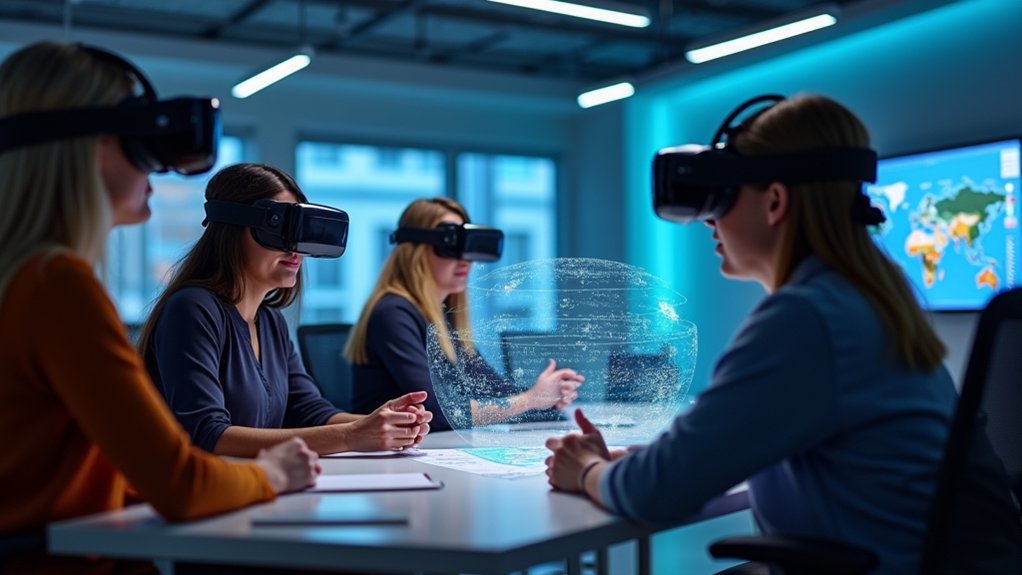
As you evaluate virtual reality training solutions, determining how well they’ll integrate with your existing Learning Management System becomes essential for maximizing your investment.
Over 50% of companies prioritize integration compatibility when implementing VR training programs, recognizing that seamless connectivity prevents VR from becoming an isolated tool.
Your chosen system should provide centralized access to all training materials while enabling flexible content creation for tailored training experiences that meet specific industry requirements.
A truly effective VR training solution must seamlessly blend with existing resources while offering the flexibility to create industry-specific content.
Focus on these critical integration elements:
- Data tracking capabilities that sync performance metrics directly with your LMS dashboard
- Unified content management allowing seamless access to both traditional and VR training materials
- Customizable content creation tools that align with your organization’s specific needs
- Provider support throughout the implementation process to address technical challenges
Review Performance Tracking and Analytics Tools for Training Effectiveness
Performance tracking and analytics tools transform your VR training investment from an educational expense into a measurable business asset. These tools automatically capture participant performance data during training sessions, delivering real-time insights into knowledge retention and completion rates without manual intervention.
You’ll access detailed dashboards that reveal where learners struggle, enabling targeted training improvements based on concrete evidence rather than guesswork. By making data-driven decisions, you can continuously refine your training content and methods to maximize training effectiveness.
When you integrate these analytics tools with existing Learning Management Systems, you gain personalized learning capabilities. This integration allows you to tailor training experiences to individual employee needs, creating more engaging and effective educational pathways that directly support your business objectives.
Analyze Equipment Requirements and Technical Infrastructure Needs
When implementing VR training programs, you’ll need to evaluate your organization’s technical foundation to confirm peak performance and user experience. Your VR equipment must align with industry-specific software requirements for seamless integration.
Check hardware specifications against your training platform’s demands, verifying adequate internet bandwidth supports data-intensive applications.
Consider these essential equipment requirements:
- Hardware compatibility – Verify VR headsets work with your training software and meet minimum system requirements
- Ergonomic setup – Choose comfortable equipment that reduces fatigue during extended training sessions
- Tracking capabilities – Confirm precise motion detection for accurate skill development and realistic interactions
- Environmental durability – Select ruggedized VR headsets for hazardous training environments that demand extra protection
Your technical infrastructure directly impacts training effectiveness, so invest time in thorough compatibility assessments before deployment.
Partner With Experienced VR Training Providers for Seamless Implementation
Collaboration with seasoned VR training providers transforms complex implementation challenges into streamlined deployment processes.
You’ll leverage their specialized knowledge to navigate technical complexities while ensuring ideal resource allocation for your training programs. These partnerships grant you access to extensive libraries of immersive training content specifically designed for your industry, delivering more relevant training experiences.
Experienced VR training providers maintain systems that provide centralized access to all learning materials, simplifying your team’s training journey.
They continuously refine content based on user feedback and evolving industry trends, ensuring your programs remain current and effective.
Frequently Asked Questions
What Are Three Disadvantages to VR Training?
You’ll face reduced job satisfaction from lacking human interaction, struggle with less effective communication compared to traditional methods, and risk developing weaker critical thinking skills through over-reliance on virtual systems.
How Do I Get Into the VR Industry?
You’ll need to gain skills in computer science, game design, or 3D modeling. Build hands-on experience through projects, network with industry professionals, and earn certifications in VR-specific software tools.
How Much Does VR Training Cost?
VR training costs range from $1,000 for basic programs to tens of thousands for advanced systems. You’ll face additional expenses for updates and maintenance, but subscription models can reduce upfront costs considerably.
Does Jayden Daniels Use VR Training?
You won’t find confirmed reports that Jayden Daniels uses VR training specifically. However, many quarterbacks are adopting VR technology to enhance decision-making and practice plays, so it’s becoming increasingly common.

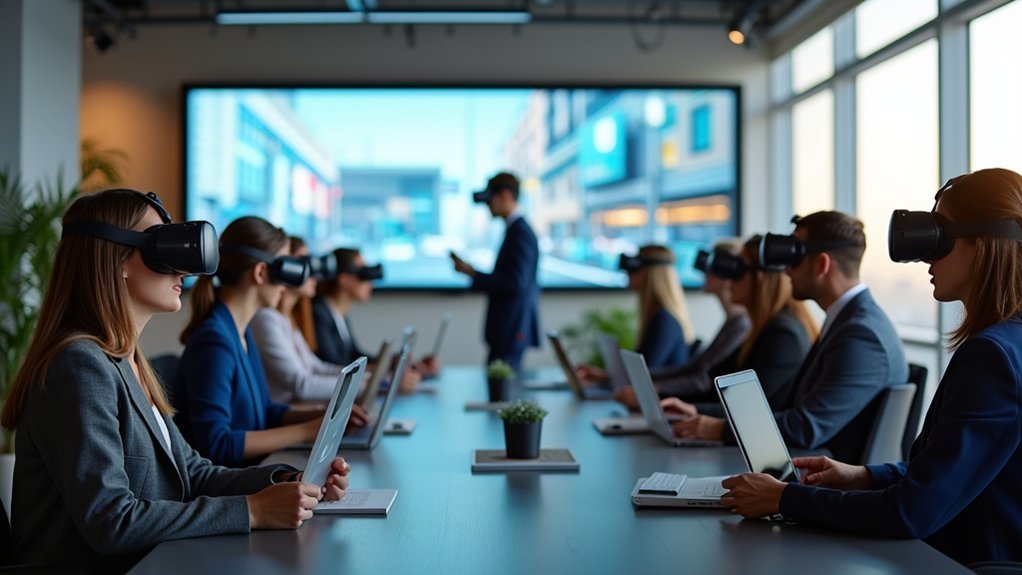
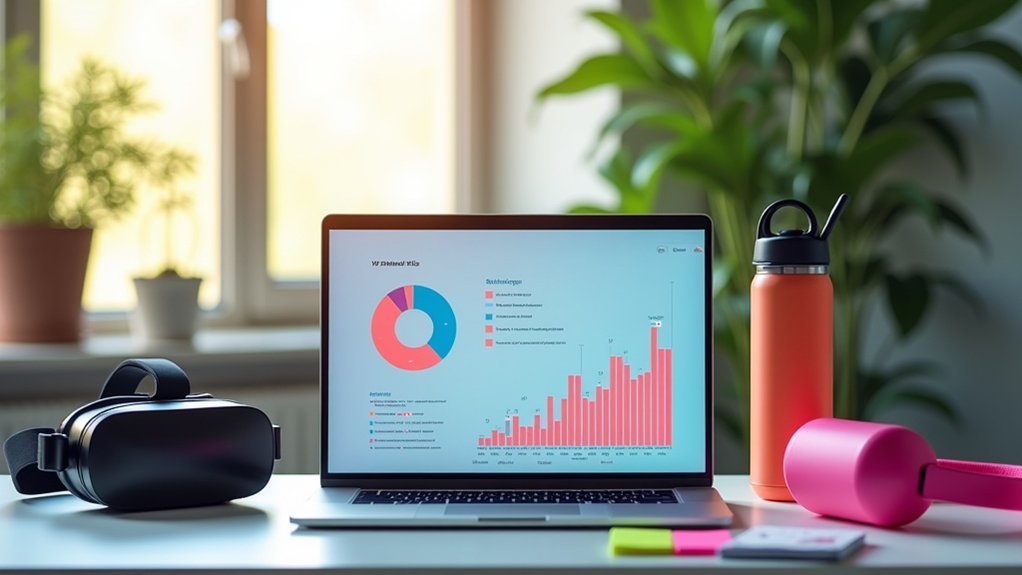

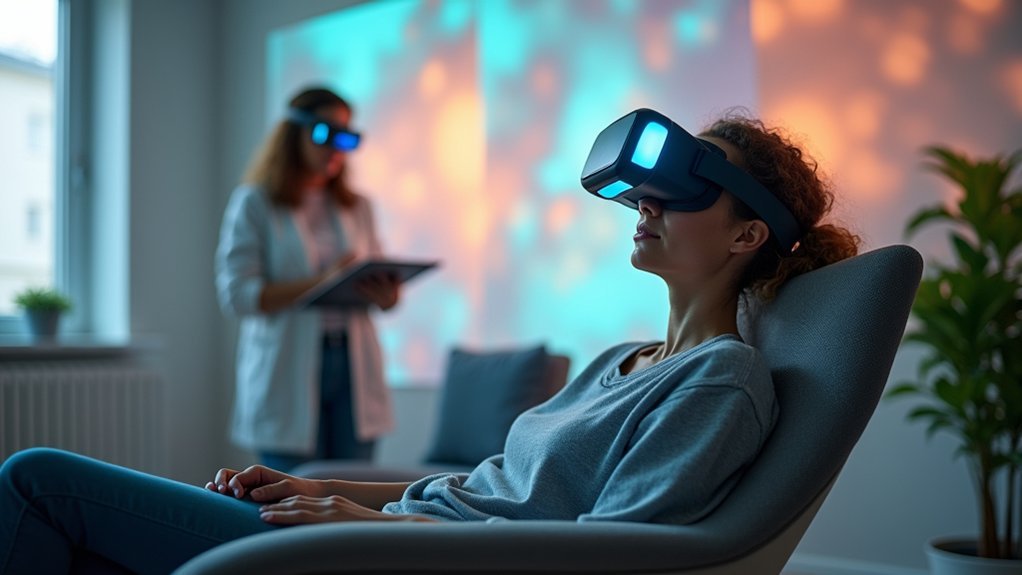
Leave a Reply